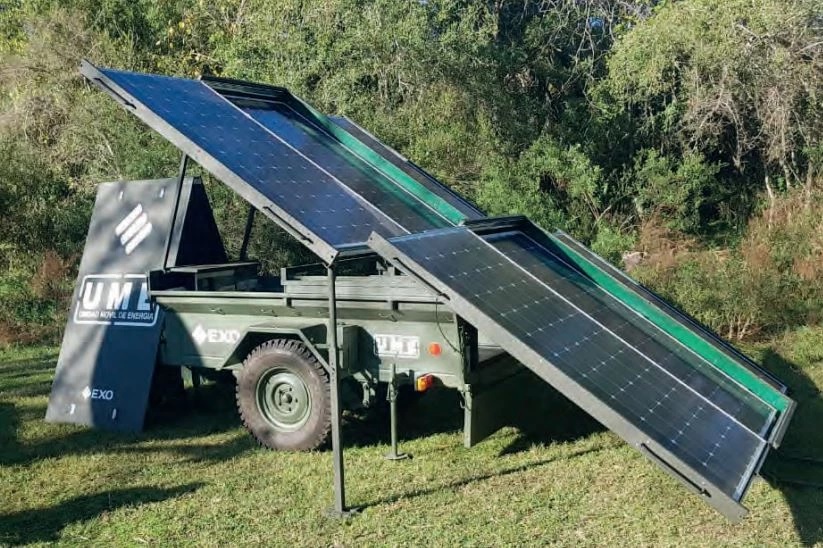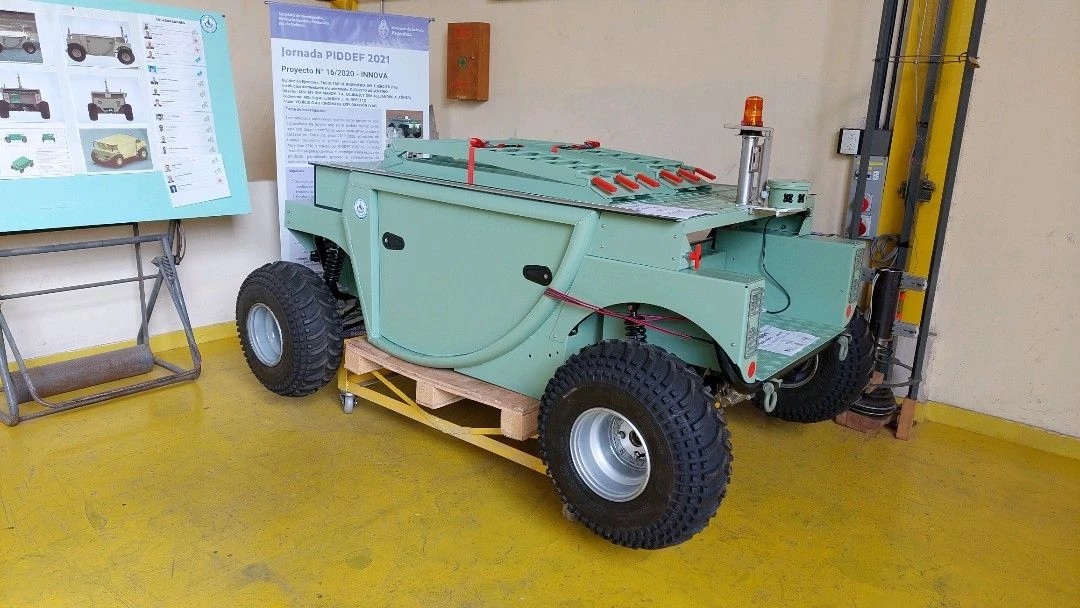Argentine defense companies and national organizations exhibited technological innovations to the Argentine Army as part of the Soldado Ugalde exercise, which InfoDefensa attended at the Concepción de Uruguay Military Garrison, Entre Ríos, from October 17 to 21.
The projects presented were uncrewed ground vehicles, special engineering tools, state-of-the-art explosives systems and materials, decontamination systems, personnel protection systems, and demining and mining materials, among others.
MOBILE ENERGY UNIT (MEU)
The MEU project, developed by EXO, was born from the need to provide deployed troops with an alternative power source.

The MEU can capture and store solar energy – in a transportable module mounted on a semi-trailer trailer – to provide power to military units, medical units, and health modules day and night.
The unit can be placed on any terrain and installed in less than 15 minutes by three people.
Depending on the needs, its capacity can be expanded by adding more modules. The dimensions of the deployed trailer are 3x3x3 meters, and the surface of the solar panels is 12 square meters.
The EMU has a power of three KVA and has an autonomy of eight hours without sunlight, with an average consumption of one kw. It has no electromagnetic or heat irradiation.
MOBILE DIAGNOSTIC CENTER (CDM)
The CDM is another project of EXO, together with the National University of Rosario, that facilitates remote medical diagnosis.
This telemedicine instrument, which has an integrated notebook, can perform echocardiography, respiration, oximetry (SpO2), heart rate, non-invasive blood pressure (NIBP), and surface temperature studies.
The results are displayed on a screen and can be stored for later analysis or transferred in real time via Wi-Fi, cell phone network, or satellite.
In addition, it has a rotatable 2 MP camera that allows videoconferencing for support by a medical professional in a healthcare center.
Its small size, 300 mm long, 212 mm wide, and 84 mm high, and weight of four kilograms make it an ideal instrument to be used in areas of difficult access.
Currently, this equipment is located in all permanent Antarctic bases, and all of them report to a medical platform, also from EXO, where all the studies performed in the bases are sent to the chief of the Joint Antarctic Command health.
In addition, there is equipment in the icebreaker ARA Irizar, the frigate ARA Libertad, the Central Military Hospital, and the White Helmets use it in humanitarian missions such as in Madagascar and Mozambique.
AUTONOMOUS EXPLORATION VEHICLE (AEV)
The AEV is a development of the General Directorate of Research and Development of the Argentine Army in conjunction with the Army Engineering Faculty (FIE) financed by the PidDef 2016 and PidDef Innova 2020 programs with a sum of around ARS 4 million (US$25,000).
This multipurpose vehicle project is currently in its third prototype.

AMERICAN ROBOTICS UGV
The company American Robotics, part of the Mirich group, presented its Unmanned Ground Vehicle (UGV) for exploration to be used in dangerous environments, which will allow for saving lives and fulfilling the mission while reducing risks.
The tracked vehicle can adapt to any terrain. Its two electric motors make it very quiet when carrying out exploration tasks.
It is equipped with solid-state 3D LiDAR sensors that allow not only autonomous navigation but also the construction of the environment, creating three-dimensional maps of the places where it travels.
In addition to its front 3D camera, which is used for navigation and observation of nearby obstacles, it has a state-of-the-art bi-spectral camera system capable of spotting vehicles at four kilometers and people at one and a half kilometers in total darkness and in any weather.
It also has a 4MP (ultra-high definition) long-range optical PTZ of 52X with night vision.
In addition, it has 360° fixed cameras capable of recording, storing, and transmitting everything that happens in its environment—also equipped with multiple proximity sensors, ambient microphones, two-way communication, and many other features.
The UGV can, through artificial intelligence, perform different tasks in different environments.
In turn, it can be customized to perform whatever the customer needs, and different sensors can be incorporated to measure Co2, gases, temperature, and any other sensor available in the market.
With information from InfoDefensa

